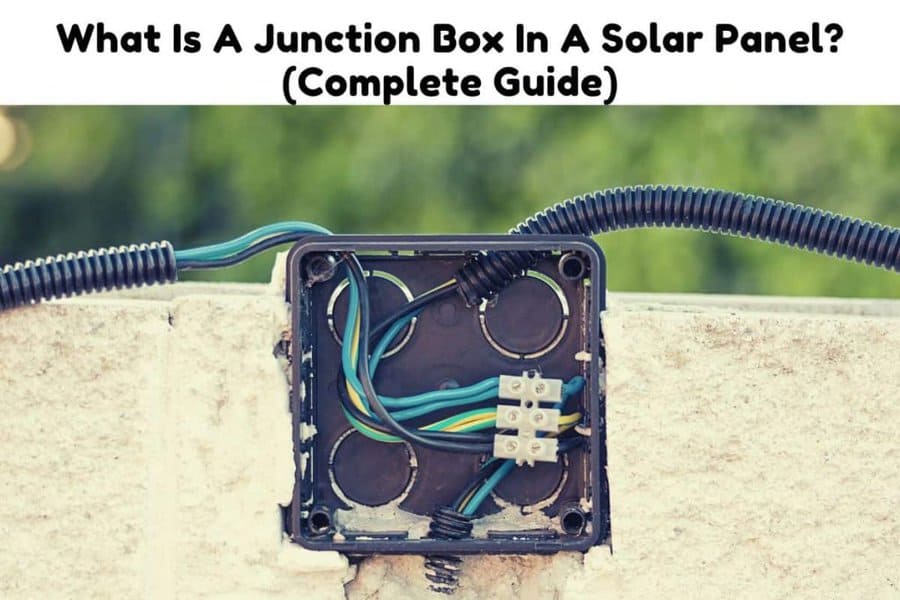A solar panel does not have moving parts. Fortunately, this means less wear and tear which gives it an edge over a generator for example. Besides the solar cells that produce energy what other components make up a solar panel?
A glass cover protects the solar cells from damage. The metal frame holds the different pieces together. Then there is the junction box. The primary purpose of the junction box is to switch from the solar panel wiring to MC4 or MC5 connectors.
In today’s guide, we look at what a junction box does on a solar panel and how to install one. We also look at what the PN junction of a solar panel is. Is it the same as a junction box?

What Is The Black Box On The Back Of A Solar Panel?
The black box on the back of a solar panel is the junction box. The junction box transitions from the internal wiring of a solar panel to the external wiring that connects the solar panel to the rest of the system.
On a side note! If you’re in need of a reliable and high-performance portable solar panel, We strongly recommend the Jackery SolarSaga 100W Portable Solar Panel (Amazon Link).
With a high conversion efficiency and foldable design, this solar panel is easy to transport and set up, making it perfect for outdoor activities like camping, hiking, and RV trips.

The US solar cell technology used in this panel ensures that you get the most efficient and reliable solar charging possible.
There is also a 60W option that is more affordable (Amazon Link)
A solar panel has wiring or conductors which carry the electricity produced by the solar cells. This electricity needs to be carried out. The internal wiring of a solar panel is unsuited to carry that electricity out. You need a different type of wire for that.
A junction box provides an inlet from which you can connect the solar panel to either another solar panel or to a microinverter.
It is a bridge between the solar panel to the rest of the system.
Naturally, the connection has to be protected from tampering and the elements. Exposed wires would be dangerous and vulnerable to corrosion so the connection is safely housed in a protective box.
Junction boxes allow you to make clean, insulated electrical connections. In the case of a solar panel junction box, it allows you to make a waterproof connection that protects the wiring from moisture.
What is inside a junction box?
A simple solar panel junction box will have a negative and positive terminal and blocking or bypass diodes. The terminals are where the negative and positive MC4 connectors plug the solar panel into the rest of the system.
Also, Check out our post on Which Solar Panel Connector Is Positive? (Types Listed)
The diodes are there to prevent electricity from flowing in reverse and feeding the solar panels. The electricity should flow from the solar panels to the system and not the other way around. Diodes prevent this from happening.
A good quality junction box has to be weather, water, temperature, and light-resistant due to the extreme conditions to which a solar panel is subjected.
Junction boxes come in different ratings from IP65, IP67 to IP68. An IP65 junction box is dustproof and partially water resistant. An IP67 junction box is dust resistant and can be immersed in water up to a depth of one meter. An IP68 is dust resistant and can be immersed deeper than one meter. Source
How Do You Install A Solar Panel Junction Box?
Modern solar panels come with the junction box attached or pre-installed. The junction box will be screwed to the backsheet of the solar panel. In some models, the junction box will be stuck to the back sheet with silicone.
To install a new junction box these are the steps you need to take:
- Make sure the backsheet and contact ribbons are clean.
- Place silica gel around the bottom edges of the junction box where it will be stuck to the backsheet.
- Place the junction box on the solar panel, passing the contact ribbons through the holes of the junction box.
- Solder the contact ribbons to the junction box.
- Test the solar panel in sunlight. Use a multimeter to check the open circuit voltage and current.
How Do You Open A Solar Panel Junction Box?
To open a solar panel junction a flat instrument such as a screwdriver is needed. Place the screwdriver on the snapping points along the lid of the junction box. Gently push downwards until a snapping or clicking sound is made. This indicates the top lid has separated from the rest of the junction box. The lid should easily pop out without breaking.
How Do Solar Panels Work PN Junction?
A solar panel has two layers. These are the Positive or P-Type layer and the negative or N-Type layer. These two layers are placed together to form the PN junction. The PN junction is the region in which electrons and electron holes combine and create current.
Raw silicon is a poor conductor of electricity. It has to be treated or doped with another material such as phosphorous or boron to improve its conductivity.
Doping silicon with phosphorous introduces an extra electron into the silicon making it more conductive. This is the N-Type layer. Doping silicon with boron creates an electron-hole or acceptor. This is the P-Type layer.
Joining these layers creates a p-n junction where electrons flow from the N-Type layer to the P-Type layer while electron holes migrate in the opposite direction. This movement of holes and electrons occurs when the layers are exposed to sunlight which contains energizing particles known as photons.
When electrons are exposed to photons, they become energized and create an electrical current. This is what is known as the photovoltaic effect and is the fundamental principle of how solar cells work.
What Are The Components Of A Solar Panel System?
A solar panel system has four main components. These are solar panels, inverters, charge controllers, and batteries. The precise configuration of a solar system may differ and not all systems will use all these components. The only part of a solar system that is indispensable is the solar panels themselves.
A popular design for a solar system is to have solar panels and an inverter but without a battery. Charge controllers are used only when there is a battery. This type of system is called a grid-tie system as it is connected to the grid.
An off-grid system will always have a battery as there is a need to store energy for nighttime use. In an off-grid system, as the name suggests, there is no grid connection.
